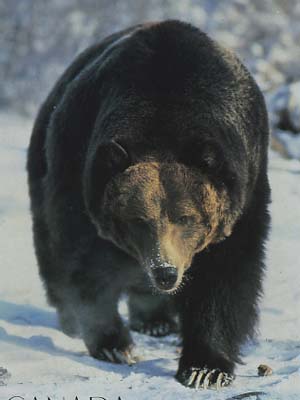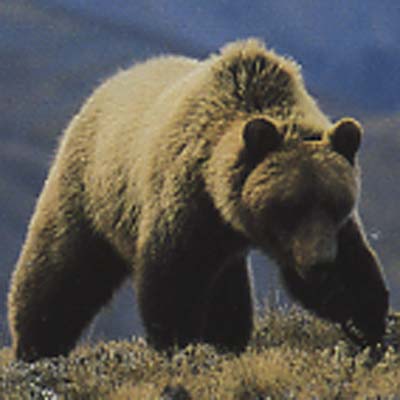

The Great Bear Rainforest
En la Norte Costa de occidental Canadá es situado
Osa Mayor Rainforest. El tamaño de este gubernamental " desproteger
rainforest , consistir de 1,000 año antiguo cedro árboles , es
aproximadamente 3.2 millón hectárea (8 millón acres ) Cada
año el lloriquear bajar del alto sierras al Nekite río a alimentar
sobre el regreso desove salmón.
On the North Coast of western Canada is situated the Great Bear Rainforest.
The size of this governmentally "unprotected" rainforest, consisting
of 1,000 year old cedar trees, is approximately 3.2 million hectares (8 million
acres.) Each year the grizzlies come down from the high mountain ranges to the
Nekite river to feed upon the returning spawning salmon.


Un oso pardo lata medir hasta kg. (800 libras ) y pozo
alimentación sobre el desove salmón lata ganar hasta kg. (6 libras
libras ) por día. El osos necesidad a cebar arriba ante ellos hybernate
( sueño ) por lo largo frío invierno. Allí está
corrientemente 40 a 50 oso descenso al río a alimentar. UN madre oso
pardo lata parir hasta cuatro cachorros ( bebé osos ). La madre oso testamento
cuidar ella joven por tres años ante ella enviar ellas afuera a el mundo
a mantener ellas mismas. En Canadá , aproximadamente 5 a 10 personas
está atacar a muerte por osos cada año. Salvaje osos está
muy peligroso , especialmente un oso pardo.
A grizzly bear can weigh up to 390 kg. (800 pounds) and well feeding upon the
spawning salmon can gain up to 2.7 kg. (6 pounds pounds) per day. The bears
need to fatten up before they hybernate (sleep) for the long cold winter. There
are currently 40 to 50 bear coming down to the river to feed. A mother grizzly
bear can give birth up to four cubs (baby bears). The mother bear will care
for her young for three years before she sends them out into the world to fend
for themselves. In Canada, approximately 5 to 10 people are mauled to death
by bears each year. Wild bears are very dangerous, especially a grizzly bear.
Situado en la ensenada ( herrero ) que guía a
el Norte Nekite río es Osa Mayor Pabellón. El pabellón
se , interés bastante , es accionado por solar y energía energía.
El ensenada es rodeado por torre montañas y no solo lata un visitante
ver grisáceo engranajes , pero también ; negro osos , lobos ,
nutria , y calvo águilas. El pabellón proporcionar diaria viajes
por personas aquel venir de en todo el mundo a ver el splindine paisaje y fauna
salvaje. El pabellón lata estar accesos por bote o por avión.
Si usted toma el agua taxi desde Vancouver Isla al pabellón allí
es un bueno azar aquel usted testamento ver delfines , sellos , morsa , y ballenas.
Situated on the inlet (Smith) leading into the North Nekite river is the Great
Bear Lodge. The lodge itself, interest enough, is powered by solar and energy
energy. The inlet is surrounded by towering mountains and not only can a visitor
see grizzly gears, but also; black bears, wolves, otters, and bald eagles. The
lodge provides daily tours for people that come from all over the world to see
the splindine scenery and wildlife. The lodge can be accessed by boat or by
aircraft. If you take the water taxi from Vancouver Island to the lodge there
is a good chance that you will see dolphins, seals, walruses, and whales.
Quiz:
1. Is the rain forest governmentally protected or unprotected?_____________________
2. Why do the bears come to the river each year?_____________________
3. What is a baby bear called? __________________________
4. What is the weight a grizzly can grow to?___________________________
5. How much weight can a grizzly acquire each day upon feeding on the salmon.
_____________________________6. Water taxi is one way of reaching the lodge. What is the other?
________________________________7. Name the bird mentioned in the above article?__________________________
8. How old is a cub before the Mother bear sends him or her out into the world.
________________________________9. Wind power is one source of power for the lodge. What is the other?
_________________________________10. What is the name of the 1,000 year old trees mentioned in the above article?
_________________________________
11. What is it called when a bear sleeps through the long cold winter?